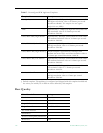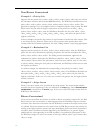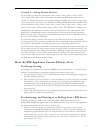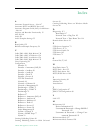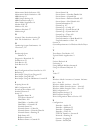
138 © 2008 VBrick Systems, Inc.
Non Bitrate Constrained
Example 1 – Priority List
Suppose that the priority list is video
1
, audio
1
, video
2
, audio
2
, video
3
, audio
3
(do not confuse
the subscripts used here with Encoder MBR Selections). The WM Player identifies these five
pairs: video
1
, audio
1
; audio
1
, video
2
; video
2
, audio
2
; audio
2
, video
3
; video
3
, audio
3
. This
approach to parsing a list is an example of what is sometimes called a sliding window. The WM
Player selects the pair with the highest total bitrate. If the priority list is audio
1
, video
1
,
audio
2
, video
2
, audio
3
, video
3
, then the WM Player identifies the five pairs audio
1
, video
1
;
video
1
, audio
2
; audio
2
, video
2
; video
2
, audio
3
; audio
3
, video
3
, and selects the pair with the
highest total bitrate.
In these examples, the priority list contains an equal number of audio and video streams. This
is not always the case, however. There can be fewer or more audio streams than video
streams, and without further explanation, the term "sliding window" stops being appropriate.
Example 2 – Redundant List
Suppose that the priority list is video
1
, audio
1
, video
2
, audio
2
, audio
3
. How the WM Player
parses this list can be illustrated by replacing the priority list with this redundant list: video
1
,
audio
1
, video
2
, audio
2
, video
2
, audio
3
. The sliding window mechanism, applied to the
redundant list, defines which pairs the WM Player identifies: video
1
, audio
1
; audio
1
, video
2
;
video
2
, audio
2
; video
2
, audio
3
(the pair audio
2
, video
2
has been omitted, since it is the same
as video
2
, audio
2
). Among the four pairs just mentioned, the WM Player selects the one with
the highest total bitrate.
As another example, the redundant list corresponding to the priority list audio
1
, video
1
,
video
2
, video
3
, is audio
1
, video
1
, audio
1
, video
2
, audio
1
, video
3
. The WM Player identifies the
three pairs audio
1
, video
1
; audio
1
, video
2
; audio
1
, video
3
, and it selects the pair with the
highest total bitrate. In the case of a video-only or audio-only priority list, the highest-bitrate
stream is selected.
Example 3 – Script Stream
There is one more stream to be considered: the script stream. The script stream includes
metadata and closed captioning if they are enabled on the
Video page, and if Closed Caption
and Metadata
is checked on the Server page. If the server offers the script stream, then the
WM Player will consider it.
Bitrate Constrained
So far, we have described the situation in which no bitrate constraint is imposed by the WM
Player. Now we turn our attention to what happens when the WM Player imposes a bitrate
constraint. The discussion will assume that the WM Player considers the script stream, when
it is offered. The broad statement to be made is that the WM Player traverses the priority list,
starting at the highest-priority stream, and stops immediately before the bitrate constraint is
exceeded. (Note: the bitrate constraint imposed by the WM Player is, in general, slightly
smaller than the value appearing in the URL modifier.) One particular consequence is that
the WM Player might not select one stream of each type offered, where "type" means audio,
video, or script.





